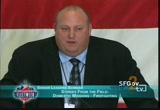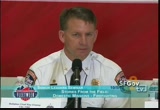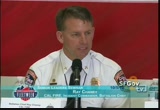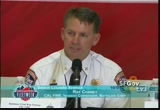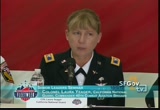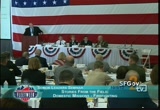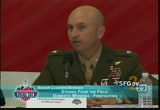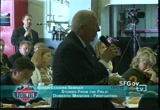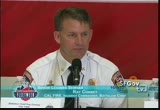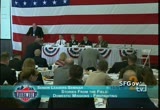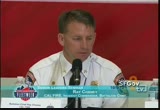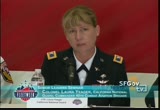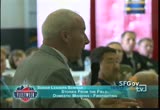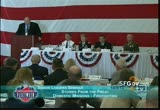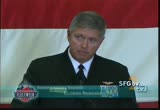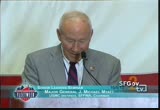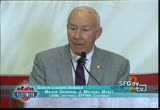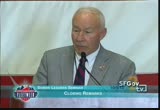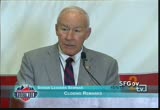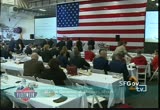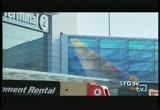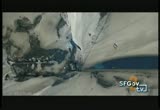tv [untitled] November 3, 2012 6:30am-7:00am PDT
6:30 am
>> well, i don't know about you all but i feel pretty comfortable going into this fire season. it sounds like we have a pretty integrated group not only within the military capability you but state and local capabilities and federal capabilities for this fire season. with that i'm going to go down the line. as we get to our military partners i'd ask if there's other technologies that you think that you have that you want to share about that may be helpful as we start to get into fire season. please share those with us. ray, if you'd like to start. >> sure, thank you. first off, thanks for being here, it's my first time being here and i think it's an outstanding venue to meet the cooperating agencies and talk about policies and ways we can improve our response to the public that we serve. we look at title 10, title 32 resources in all aspects, all risk venue, like i said, not
6:31 am
only aircraft but we utilize ltax for our agreements with la county fire, to mobilize fire engines to catalina island. we look at resources for debris cleaning, i found out there's a desalization battalion for fresh water, that's an i object credible resource for an earthquake. there's a variety of dod resources that cal fire can provide in a statewide environment. i think the biggest thing for me, there's several scenarios that are challenging us, one of which and one of our fears, and it's been in the newspaper so it's not a secret, but one of the things that scares me as well is the united states is not really experienced what i would call a global disaster yet. we have had disasters, i
6:32 am
was in katrina on an urban search and rescue team, i've been in pretty much all major engagements as far as wild land fires in california, but if you look at a global disaster perspective where you have a hundred thousand victims like a tsunami or a large scale event, we have yet to experience that in this nation. i think the agreements we have here today and the relationships we develop today are going to be key to mitigate that. the other scenario that we are concerned with is a coordinated aerial incendiary attack by al qaeda. one of the things we've seen already in the european union is suspect of al qaeda starting fires in the eu if that happened in california in the right weather conditions, it would be disasterous and everybody in this room would likely be involved.
6:33 am
but to go back, it's all -- for me it's all about relationships, it's all about communication and respecting each other's mission. we certainly appreciate our relationships with all 3 agencies up here. the last thing i would say with respect to technology, one of the things as a command and control tool that cal fire is experimenting with is a program that dhs science and technology created and if you are ready to write it down, you can look online, you can google it, it's called the next generation incident command system or nics. it's a command and control web-based tool that we're looking with mit lincoln labs and dss and i would foresee when we stand up our wing operation center at miramar that the marine corps liaison and the navy liaison and if need be the guard liaison would have access to
6:34 am
that tool. the next generation command system is a fantastic web-based command and control technology that we expect to use in the future. with that, thank you. >> thanks. colonel yeager. >> i just want to say you can't underestimate the risk presented by these environments we fly in and really the relationships that we build with cal fire and the training prepares us to mitigate that risk. as rear admiral riveras said, bad things tend it happen at night. they also happen on the weekend and i think we have a 3-day week jepld here but i assure you we are ready to respond. >> from personal experience in 2007, i started training for fire fighting in 2006 but in 2007 was my first actual experience fighting fires and as i went in for my first dip in san diego to fill the bucket about two miles away was my brothers and my brother's house, his wife and my two nephews and that's when this
6:35 am
capability really hit home for me, that it's an important thing. as was said before, every member -- we're all members of the community as well and it's all extremely important. the fire fight is important to us and we are ready and we count on the relationship that we have with cal fire. in fact, that's probably the most essential part of this thing for us to be ready to fight future fires. >> colonel. >> thank you very much for allowing us to come here and participate because it is important. we really appreciate very much this opportunity. we're doing well right now but there's khal lefrpgs we can do better on and that's exactly what we're looking forward to do. we're looking forward to build upon and leverage what we're doing here. communications, that was one of
6:36 am
the first things. it's different with our active duty forces because you see here, we send our aircraft all around the world. we can't necessarily just invest in some components in the aircraft and call it good because those assets may be gone and deployed but we have work arounds for that. we are looking forward to that as well in addition to the training. lastly is we again kind of relish the opportunity to participate in the operations against an active enemy. at least here, it's fire. we appreciate the fact we can go ahead and enter a tactical command air control. those are operations that are familiar to us and they are, it's a great exercise for us tactically as well. we are able to integrate with cal fire itself with the objective being the fire itself. those work out for us here and we can go ahead and use those skills forward as well. thank you very much, we
6:37 am
appreciate the opportunity. >> thank you, i'd like to thank our panelists and open it up to our group for any questions of our panelists today. yes, sir, secretary. >> there are a lot of things you can do in a forest that tend to make it easier it fight a fire like most importantly burning off the fuel during the wet season so there's less for the fire to feed on. to what extent in cal fire and all your other things do you encourage people to do things in their forest when you don't have a fire that make it easier and more effective in fighting the fire? >> it's an excellent question, sir. we spend a large time in cal fire on public education and prevention and also with respect to you were talking about fuel, the fuels program, or vegetation management
6:38 am
program in cal fire, we have a robust program throughout the state where we are conducting burning operations and vegetation management with prieflt ranch owners and private land owners as well as on state and cooperating with our federal agencies with the u.s. forest service. so two-fold program, vegetation management, we aggressively pursue that, but also from a public education stand point. what we find in these large scale incidents, the public is going to have to be self-sustaining and self-supporting. they need to be prepared. we try to educate them in respect that we say we'll provide the offense, you provide the defense. we talk to them about hardening their structures in a defensive measure against wild land fires. a lot of it is public education, survivability, building standards, but predominately our focus is putting the onus on the land
6:39 am
owner, putting the onus on the private property owner, we will attempt to protect your home but the days of staying and defending your home and killing our fire fighters are done. we will not stand and defend a house that has not been prepared by a land owner and die for it. we don't do that any more. that's one of our doctrinal changes and we set forth some new guidelines with that. >> thank you. >> question, mr. secretary. >> in a large scale disaster relief, where the military is called in to assist the civilian components there is an obvious issue of how you get the command and control and in particular what telecommunications is used to support that command and control. your exercising together is very critical, i think, to working out command and control but you still have an equipment problem because the equipment, telecommunication equipment designed for the military was different from that used. how
6:40 am
are you working out to get the coordination of telecommunications, particularly in disaster relief where the cellular infrastructure may be broken down and not available to support? could you comment somehow are you going to work out this telecommunications problem. >> so from a perspective of fema, we not only have a defense officer appointed by dod embedded with us during a disaster but we actually practice and have communications interoperatability over our systems to be sure we can communicate with each other on similar platforms and also support state and local platforms, whether it was katrina or other events we've actually been able to bring in national guard platforms to provide 911 systems for cities that have lost those systems. we recently in the joplin tornados and also tuscaloosa
6:41 am
tornados we brought in dod equipment to replace what was destroyed. from the fire side i know there's a lot of things you are doing to work around the interoperatability issues with regard to communications between fire and dod and maybe if ray or anybody else wants to speak to that. >> our communications challenges still exist. we have excellent telecom communications, we have a layered effect of our radio systems. we have mobile command posts that we can exercise. so we're prepared for power outages, reduction of telecoms, we have a layered effect for our communications. but as everybody here said, we need help. if somebody here can help me get a navy or marine corps aircraft to talk to my guys on the ground tactically, i need that and i don't have that today. i use a command control helicopter, a
6:42 am
civilian helicopter, to handle that and transfer that to an air to air victor frequency. but from a command control perspective, we're fairly robust. are we perfect, no, but we do have layered defenses against that. >> miss yeager, i don't know if you want to say anything from a national guard perspective. >> we have some mobile explorable platforms we can send out to incidents to help provide additional infrastructure in the event everything breaks down then our units have organic communications capability so i can move that out and i can help reinforce cal fire on their incident with what i have in the aviation brigade and units through the state of california have that same communication but the iceu, which is a mobile communications platform, is ideal in events like this to push out to help. >> any other questions?
6:43 am
>> i have one. back in 1992 when it was a big fire season and there was a lot of grass, they came to us and i was down at camp pendleton and they asked us it train marines on shovel work. what happened about 6 months later, they ended up sending two battalions to yellowstone. i haven't heard any discussion at all, do you expect the military, the guard or the active forces to be training people to do shovel-like work? all you have talked about so far is aviation. >> one of the challenges with a ground-based attack and training a soldier to be a ground-based fire fighter is the training takes time. and it takes approximately 3 to 5 days of solid training to make sure that they are going to be working in a safe environment to learn what's going on. and
6:44 am
most of the time that, the incidents in california will become mitigated. now, not to say that we certainly have that as an option. we have a fairly robust what we call fire crew program using cdcr inmate fire fighters. it is on our radar and it's something that we have as a contingency if we needed to do it. >> lieutenant colonel. >> yes, general, in the mou it does address the ground portion but the focus of effort is mainly on the aviation side but it is built in there for the ground side if necessary. >> i just want to say in 2008 we did activate hand crews to fight fires and we've identified soldiers throughout the state to respond if needed. they've got the tools that they need, the boots and all
6:45 am
that cached and available. it's really just a matter of getting the call and being ready to go. >> i was going to end with general myat. i know we've trained soldiers to do that kind of thing. after the colorado fires just recently they did put a lot of soldiers that trained, so we do still have that program who can do that if the need warrants. any other questions from out there before i turn it over to general myat? let me thank our panel here. >> thank you. (applause). as we leave here today, we
6:46 am
need to keep the ball moving forward. we can't -- i think most of us all here would agree, we really can't prevent the next disaster from happening. but by building the partnerships that we are here today and will continue to build in the future, we can certainly limit the number of deaths and long-term destruction. we can surge a lot of things: resources, people. but we cannot surge trust. so venues such as this is what helps us build that trust so that when the bell does go off we know -- a comment i made yesterday and i'd like to use it again in closing today, the most important thing for me to come out of this two-day seminar and sbat -- into the future is the ability for us to physically
6:47 am
face to face look each other in the eye, shake hands and say to each other, we are in this together. thank you, ladies and gentlemen. . (applause). >> thank you, admiral beeman. you have helped me carry out one of the instructions secretary schultz gave to me 3 years ago, bring the fleet back to fleet week. we couldn't do it without you. i thank secretary and mrs. perry for coming, just -- i know it's, you've got some other things, people are waiting on you right now but i really appreciate you coming here. of course secretary and mrs. schultz for the entire program. vice admiral nathan, i don't know if he's here, he
6:48 am
may have gone already, but he gave a great talk yesterday on the medical side. and vice admiral z, coast guard, our senior rep here, i can never pronounce his name but he's made things great. general speese, thank you for making this happen. rear admiral hubner, he was here, he's been terrific working with us. rear admiral rivera coming up from the chilean navy, thank you so much. i learned a lot. we need the kind of input that we got from you, really, and we thank you so much. i would be remiss not to mention the two people that really are responsible for all this. first was lewis loeven. lewis loeven works hours and hours to do this. thank you so
6:49 am
much. but the other is because she's committed to make it happen and it's her focus that always to learn from everything that happens, ann koninberg at dem, thank you so much, ann, for everything you do. you had to have a pass to get on the ship. i've asked captain pringle, to get off the ship, i wonder if you can secure the hatch until they fill out their participant form. if you could do that, i would appreciate that. fleet week, we are a neutral convener of the process to improve the relation ships between this global force for good and the local civilian officials. and one of our goals is next time you put up your slide with all those logos
6:50 am
on it, general, you are going to have the san francisco fleet week logo on it, too. i look at what we accomplished in 2010, we had a meeting to understand dsca, in 2011 we had the table top exercise, we debriefed that, we had a great speaker then we had an education seminar. this time, this year we had a functional exercise in august which was terrific, you saw the panel, a medical exercise as part of fleet week and you saw the enthusiasm of the participants, then we had the back brief. now we've had a strategic operational and tactical discussions about going forward and the things that we can accomplish. so what are you going to do in 2013? well, fill out the form and tell us what you think we ought to do but we're going to be working hard to move this forward. i think ray cheney said it from cal fire best today: we are all better off
6:51 am
because we're in here for the last day and a half and i'm sitting here wondering, all my contemporaries, what have they been doing for the last 36 hours? they haven't been doing anything near as important as what we've been doing. i thank all of you so much for participating and stay in touch. if we've got your email address you will never be lonely because we're going to get you back here next year. thank you all so much. (applause).
6:52 am
6:53 am
american airlines and virgin america was designed by a world- renowned architecture's firm. originally built in 1954, the building underwent massive renovation to become the first registered terminal and one of the must modern and sustainable terminals and the united states. the public art program continues its 30-year legacy of integrating art into the airport environment with the addition of five new commissions that are as bold and dynamic as the new building. >> this project was completed in record time, and we were able to integrate the artist's early enough in the process that they could work with the architect said that the work that is completed is the work that really helps complement and instill the space as opposed to being tucked away in a corner.
6:54 am
>> be experience begins with the glass facades that was designed with over 120 laminated glass panels. it captures the experience of being under or over clouds when flying in a plane. depending on the distance or point of view, it can appear clear for more abstract and atmospheric. the subtle colors change gradually depending on the light and the time of day. >> i wanted to create an art work that looks over time as well as working on in the first glance. the first time you come here, you may not see a. but you may be able to see one side over the other. it features a couple of suspended sculptures. each was created out of a series of flat plains run parallel to each other and constructed of steel tubing.
6:55 am
>> it is made up of these strata. as the light starts to shift, there is a real sense that there is a dynamism. >> it gives the illusion that this cultures might be fragments of a larger, mysterious mass. >> the environmental artwork livens it with color, light, and the movement. three large woven soldiers are suspended. these are activated by custom air flow program. >> i channeled air flow into each of these forms that makes it move ever so slightly. and it is beating like a heart.
6:56 am
if-0 when as of the forces of nature moving around us every second. >> shadow patterns reflect the shapes of the hanging sculptures. the new terminal also features a children's play areas. both of the market the exploratory n.y. -- exploratorium. the offer travelers of all ages a playful oasis. using high quality plywood, they created henches shaped like a bird wings that double as musical instruments. serving as a backdrop is a mural featuring images of local birds and san francisco's famous skyline. >> in the line between that is
6:57 am
so natural, you can see birds and be in complete wilderness. i really like that about this. you could maybe get a little snapshot of what they are expecting. >> it is an interactive, keck sculpture that is interacted with by the visitor. >> they are a lot about and they fall down the belt. it moves the belt up, and if you turn that faster, the butterflies fall in the move of words. >> the art reflect the commission's commitment to acquiring the best work from the bay area and beyond. in addition to the five new commissions, 20 artworks that were already in the airport collection were reinstalled.
6:58 am
some of which were historically cited in the terminal. it includes major sculptures by the international artists. as a collection, these art works tell the story of the vibrant arts scene in the early 1960's through the mid-1980s's. the illustrate san francisco's cultural center and a place of innovation that is recognized and the love throughout the world. one of the highlights is a series of three left tapestries. they are on view after being in storage for 20 years. these tapestries representing various gardens. from his years of living in san francisco. hydrangeas, chrysanthemums, and whilst dahlias in rich, deep shades as they make their way to
6:59 am
the baggage area. they can access behind-the- scenes information and interviews with the artist through an audio to work. it features archival audio as well as interviews with living artists. he can be accessed on site by dialing the telephone numbers located near the artwork or by visiting the commission's web site. the public art speaks volumes of san francisco as a world-class city with world-class art and culture. for more information, visit
132 Views
IN COLLECTIONS
SFGTV2: San Francisco Government Television Television Archive
Television Archive  Television Archive News Search Service
Television Archive News Search Service 
Uploaded by TV Archive on

 Live Music Archive
Live Music Archive Librivox Free Audio
Librivox Free Audio Metropolitan Museum
Metropolitan Museum Cleveland Museum of Art
Cleveland Museum of Art Internet Arcade
Internet Arcade Console Living Room
Console Living Room Books to Borrow
Books to Borrow Open Library
Open Library TV News
TV News Understanding 9/11
Understanding 9/11